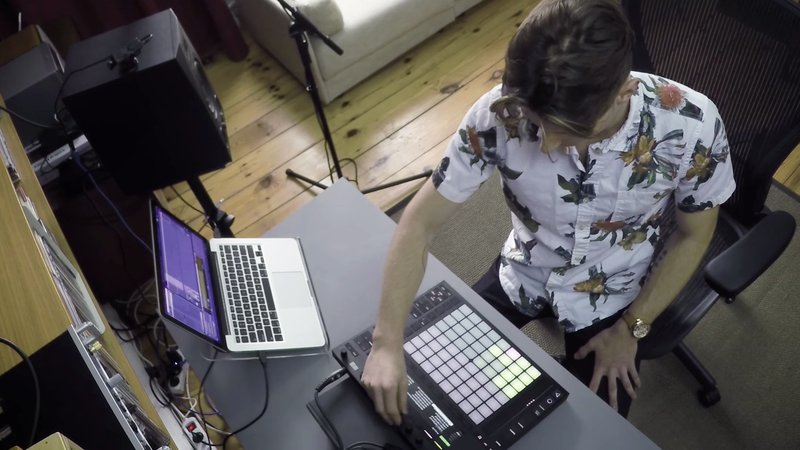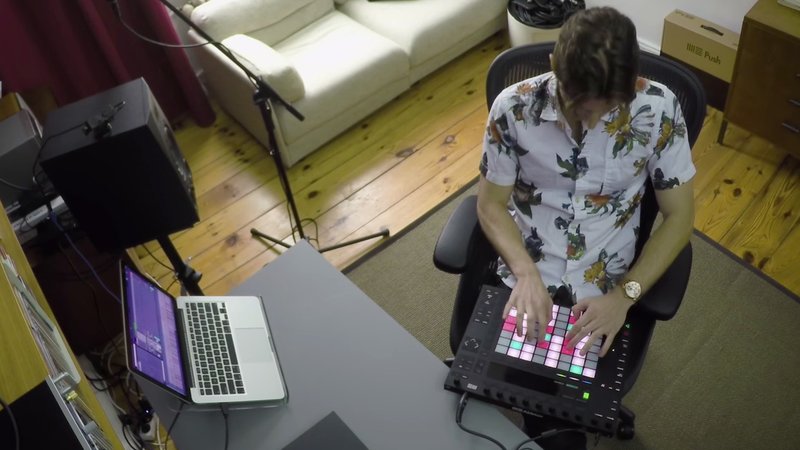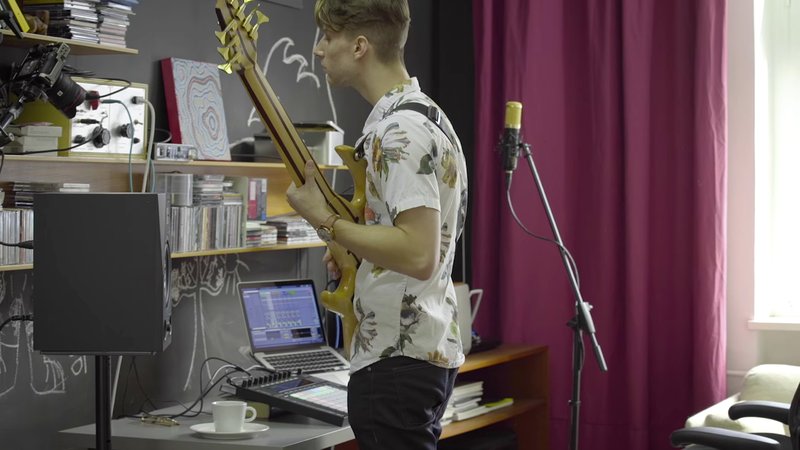JNTHN STEIN: Beatmaker at Work

We first met JNTHN STEIN while making our upcoming documentary on the Team Supreme crew of young producers. As was the case with every Team Supreme member, we were very impressed by STEIN’s beatmaking skills. However, the 25 year-old’s easygoing eloquence and highly refined production habits gave us good reason to sit him down in front of a camera with Push and ask him to make some beats from scratch.
The three resulting tracks are now available as an EP. In the video below you can watch JNTHN STEIN making one of the tracks from it – going from a blank slate to the fully formed composition “Berlin III”, and explaining the how and why of every stage of the process.
In the interview that follows, JNTHN STEIN elaborates even further on his production process – going into great depth on how he programs rhythm patterns, works out arrangements, and how his creativity draws on ideas both musical and philosophical.
Rhythms: Positive and Negative Space
In 'Berlin I', you're using some interesting placement of the kick and snare within the rhythm pattern. When working on a beat, are you as conscious of what you're leaving out of the rhythm pattern as you are of what you're putting in?
Rhythm is the full grid, downbeats and upbeats, sound and silence alike. Beats with more downbeats will have more of a downward force that makes you stomp, whereas more upbeats will create upward force that makes you want to jump and lift your heels. The amount of rhythmic density (notes sounding versus silence) creates the texture of the beat; a lot of notes filled in has more consistency and flow, feels smoother and more comfortable.
There's definitely such thing as too dense, which becomes cluttered, frantic and psychotic. On the other hand, the more sparse a beat becomes, the more suspense you can create in those silences where you have no idea what's coming next. It creates a broken jittery feel, like stop time animation or the moment before the monster pops out in a scary movie. Mixing the parameters of beat density (notes and rests) versus beat placement polarity (downbeats and upbeats on any grid) is a good way to zero in on pretty much any vibe with just rhythms, from scary and shocking and heavy to smooth and comforting and light and fluffy.
When I make beats with this in mind, I start with the basic framework of the pulse, usually the backbeats on 2 and 4 or perhaps a steady hi-hat pulse of quarter notes, something that gives the listener (and me, the composer) a stable framework for all the syncopated chaos to occur on top of. Then I'll put down the basic bass drum pattern, something melodic in itself since the bass drum is the most prominent drum and element in beats as a whole – this will become the rhythmic theme for the song. It has to be fairly simple but also intriguing and unexpected; start with a one measure pattern, duplicate it and vary the second measure slightly to create a two measure pattern, repeat process until you have something that feels like a sentence, or melody, probably around 8-16 bars. Once you've got the bass drum working against your constants of backbeat/hats/percussion, you can keep filling up the negative space that's left with more auxiliary sounds and rhythms, whether they're fast and sporadic, or syncopated on slower grids and bouncy. The trick is to have the beat sound good with just the bass drum and backbeat, so that everything else added on top can create variations and build in later parts of a track.
Working backwards works well too; sometimes with fast eclectic hat work, I'll turn on a fast grid on Push 2 like 32nd or 32nd triplet notes, create a constant stream of notes a la ratchet trap style, then tap here and there to remove some, tweak velocities to give the stream some waves and dips. In general, I prefer building from zero, it forces you to be particular about every addition and use more silence, which I find super important and effective. But never be afraid of the delete key, he is your best and most honest friend.
Workflow: Ordering Sounds, Choosing Scales, Filling the Spectrum

How do rhythms, melodies and harmonies relate to each other in terms of your workflow – do you tend to start a track by working on one of these elements first?
I pretty much always start with just drums. Rhythm is the most important and most physical musical element, a song/beat should sound good with just drums by themselves. So working on them alone in the beginning is a good way to get this going, and once you do have drums that capture all the energy and emotion you need, the rest of the layers to be added on become that much easier, because the drums are doing most of the heavy lifting. For picking drum sounds, I scroll through and consider their envelope and timbres; for a harsh aggressive beat, I'll pick drums that are brighter and have sharper transients, for a smooth fluffy or bouncy beat, darker drums with more sustain and even softer attacks catch my ear.
From there, it gets a little more flexible depending on the objective; often my next step is the bass sound, the next most important part of a track after the bass drum. Bass really is the new lead melodic voice in electronic music, which is awesome. The character of the bass sound sets the tone for the rest of the track, whether it's a fairly pure sine wave, square or saw wave-derived and therefore much brighter and thicker, has noise and other chaotic harsh elements, is electric bass and is more raw and organic, etc.
On Berlin II and III, my next step was more harmonic/melodic; I went straight to keyboard instruments, rhodes and piano respectively. I do this a lot as well, as a keyboardist with a lot of personal connection to those two instruments particularly. They allow to sketch harmony and melody simultaneously, with the melody being the top voice of your chords. Harmony in general has the most ability to affect mood and emotion in music, because it has such a long history of being used in association with pretty much every cultural movement at some point in time or another. It triggers memories constantly. The danger of starting with harmony however, is that you create too rigid a template as far as note choices and pitches, and are forced to delete and reduce from there to create variations, or create variation arbitrarily as I did with Berlin II.
"Bass really is the new lead melodic voice in electronic music, which is awesome."
It's best to start purely melodically I think, whether it's the bass that establishes the tonality itself, or more lyrical melodies that stand by themselves even without harmonic context, which allows for pretty much infinite harmonic variations that you can try as you develop the track. These melodies have to be simple, and I create them in the same technique as my drum/bass drum patterns. The end result should be catchy and singable, likely diatonic, and of a digestible size, such as a phrase that is 8-16 bars long. Or, you can throw notes and scales out the window and go with just sounds reminiscent of everyday life, and focus more on the gesture and contour of melody.
In Berlin I, I was going for something surreal and kind of scary and trippy, and intense, so my first melodic layer was that resonant plop sound – made with Collision – that you hear at the beginning. That sound has a lot of acoustic percussive qualities, but still has pitch and melodic potential. As much as the diatonic scale has humanistic emotion embedded in it, the chromatic scale has primal animalistic emotion to it. So this melody was blatantly a descending chromatic scale. Whatever my first melodic part of the track is however, I like to commit to it and see if I can use it exclusively to develop the entire track, whether it be an ostinato with any amount of variable counter material for A and B sections alike, or smaller parts of it, deconstructed to create other material, in the same way audio samples are manipulated to create god knows what in music production.
Spectrum plays a big part in the final objective too; I'm a big believer in the pink noise curve, I always try to have my final tracks reflect this so that they sound natural and close to how we hear in everyday life. Within that curve is still a lot of room to create relaxation and excitement, whether it's a section of the beat that only has drums and bass and is therefore darker and chiller, or has hats, bright synths and melodies and other 1khz and above elements that excite the ear and create intensity in other parts. The end goal is to fill up that whole spectral curve, and on the way explore as many reductions and breakdowns of it as appropriate.
To wrap up; there is a hierarchy to musical elements, rhythm being the most important and obvious element, followed by melody which creates individuality and personal connection and reflection, and then harmony which creates emotional and nostalgic context. All of this falls behind the bigger picture of spectrum however; electronic music is about the sounds of the future that don't exist yet, sounds that are merely composed of low and high frequencies and everything in between.
Arrangements: Contrast is Key

A common way of building arrangements is to make and compile variations on a theme and then put the variants into a sequence? Do you tend to work in this way as well or do you have other arrangement strategies?
To support earlier answers, I always start with a single idea that leads to an A section and all of its variations that get arranged throughout the beat to create different intensity arcs. Using the same melodic lead idea, I'll try to intentionally create a B section that contrasts as drastically as possible, with the one musical element being their only connection. Sometimes this works better than other times no doubt. But I really like the idea that any two things can be compared or mixed together, like the chaotic absurdity of culture being mixed together and thrown on top of itself.
On Berlin III [the song STEIN creates in the video above], there's a lot more overlapping material on the A and B, creating more smooth flow. The A and B share the same drums more or less, same melody, but to contrast the lush chord progression of the A, I stripped it away and went pure one-chord hard rock riff with it, creating a R n B / lush versus rock/gritty contrast.
"Whatever my first melodic part of the track is, I like to commit to it and see if I can use it exclusively to develop the entire track..."
Contrast in general is very important to me, it creates excitement and always leads to unexpected results. A good way to create material that's unexpected – even to you the composer – is to crassly mix the A and B sections together, slap them right on top of one another in some form or another and see what happens. The mere fact that the A and B had a component in common opens doors for these mixtures to work and be effective, while still being surprising and intentionally inconceivable by you, which is always fun.
To summarize; contrast is the key to creating full-spectrum art, something that shows the full range from happy to sad, sexy to scary, beautiful to ugly. You gotta show it all to make something that feels real and reminds you of real life, yet shows it to you in a way you've never heard or seen before. Contrast comes from a single idea (A), which can always be contradicted with a new perspective (B). A and B fight with each other, but in the end they coexist and become one again, creating their own full-spectrum idea (AB), that you may have given birth to, but it developed and was raised on its own without you even knowing it, and therefore carries truth beyond the scope of your ideas, thoughts, preconceptions, and ego. The end result doesn't show you; it shows your development.
Keep up with JNTHN STEIN on Soundcloud, Twitter and Facebook.